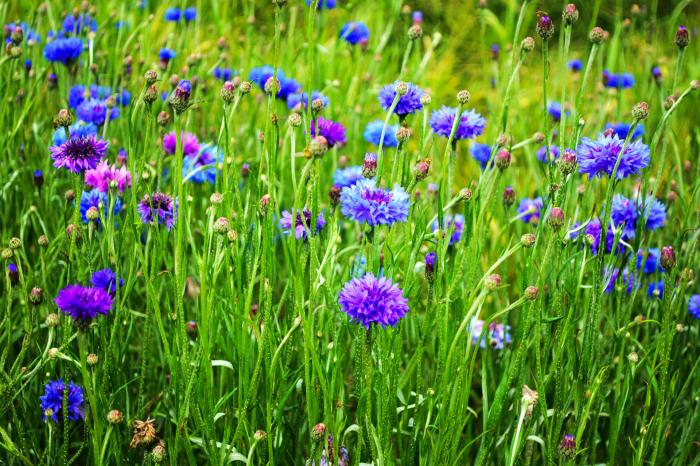Cornflowers, also known as bachelor’s buttons, are beloved for their vibrant blue blooms and delicate appearance. Drying cornflowers is a wonderful way to preserve their beauty and extend their decorative use beyond their natural bloom period. This guide will provide a comprehensive overview of how to dry cornflowers effectively, ensuring they maintain their charm for months to come.
Understanding Cornflowers
Cornflowers (Centaurea cyanus) are hardy annuals known for their bright blue, pink, or white flowers. They are popular in gardens for their ability to attract butterflies and their long-lasting blooms. Drying these flowers can be an excellent way to capture their beauty and use them in various arrangements and crafts.
Choosing the Right Time to Harvest
Timing is crucial when it comes to harvesting cornflowers for drying.
Harvest When Flowers Are at Their Peak: For the best results, pick cornflowers when they are fully open. This ensures that their color and shape are well-preserved in the drying process.
Avoid Overripe Flowers: Do not wait until the flowers start to wilt or fade. Overripe flowers will not retain their vibrant color and may become brittle during drying.
Harvest on a Dry Day: Ensure that the flowers are dry when you harvest them. Moisture can lead to mold and mildew during the drying process.
Preparing Cornflowers for Drying
Proper preparation of cornflowers is essential to ensure a successful drying process.
Clean the Flowers: Gently remove any dirt or insects from the flowers. Use a soft brush or a gentle shake to dislodge any debris. Avoid washing the flowers, as excess moisture can lead to problems during drying.
Trim Stems: Cut the stems to a manageable length, typically around 6-12 inches. This length is suitable for most drying methods and makes handling easier.
Remove Excess Foliage: Strip away any leaves or side shoots that are not needed. Focus on the flower heads to ensure they dry evenly and look their best.
Methods for Drying Cornflowers
There are several methods to dry cornflowers, each with its own benefits. Choose the one that best fits your needs and available space.
Air Drying
Bunching: Gather the cornflowers into small bunches. Secure the stems with a rubber band or string.
Hanging: Hang the bunches upside down in a dry, well-ventilated area. An area with good air circulation is ideal, as it helps prevent mold and mildew.
Waiting Period: Allow the flowers to air dry for about two to three weeks. They are ready when they feel crisp to the touch and the stems break easily.
Pressing
Prepare the Press: Use a flower press or a heavy book. If using a book, place a sheet of paper between the flowers and the book to absorb moisture.
Arrange the Flowers: Place the cornflowers between sheets of paper or parchment in the press or book. Ensure they are spread out flat to avoid curling.
Apply Pressure: Close the press or book and apply weight on top. This pressure will help flatten and dry the flowers.
Check Regularly: Leave the flowers pressed for two to three weeks. They should be dry and brittle when ready.
Using a Dehydrator
Prepare the Dehydrator: Set up your dehydrator according to the manufacturer’s instructions. Ensure the trays are clean and ready for use.
Arrange the Flowers: Place the cornflowers in a single layer on the dehydrator trays. Avoid overcrowding to ensure even drying.
Set the Temperature: Set the dehydrator to a low temperature, typically around 95-115°F (35-46°C). This helps preserve the color and structure of the flowers.
Monitor Drying Time: Drying times can vary, but it usually takes about 6-12 hours. Check periodically to prevent over-drying.
Preserving Dried Cornflowers
Once dried, proper storage is key to maintaining the beauty of your cornflowers.
Storage Containers: Use airtight containers to keep dried cornflowers. Glass jars, plastic containers, or resealable bags are all suitable options.
Avoid Sunlight: Store containers in a cool, dark place. Sunlight and heat can cause the colors to fade over time.
Handle with Care: Dried flowers can be fragile. Handle them gently to avoid breakage or damage.
Creative Uses for Dried Cornflowers
Dried cornflowers have a variety of uses that can add a touch of nature to your home decor and crafts.
Floral Arrangements: Use dried cornflowers in floral arrangements to add a splash of color. Combine them with other dried flowers and foliage for a beautiful, lasting display.
Craft Projects: Incorporate dried cornflowers into craft projects such as scrapbooking, card making, or as decorative accents in DIY projects. Their unique color and texture can enhance various creative endeavors.
Home Decor: Create wreaths, garlands, or decorative vases using dried cornflowers. They can bring a natural, rustic charm to your home decor.
Potpourri: Add dried cornflowers to potpourri mixtures. They not only enhance the visual appeal but also contribute a subtle, pleasant fragrance.
Troubleshooting Common Issues
Mold: If you notice mold on your dried cornflowers, discard them immediately to prevent contamination of other dried flowers. Ensure your drying area is well-ventilated to avoid this problem.
Color Fading: Fading colors can result from exposure to sunlight. Store dried cornflowers in dark places to preserve their vibrant hues.
Brittleness: If the flowers become too brittle, they may have been over-dried. Monitor drying times carefully to avoid this issue.
See also: How to Dry Out Flowers for Resin
Conclusion
Drying cornflowers is a satisfying way to preserve their vibrant beauty and extend their usefulness. By following these steps, you can successfully dry and store cornflowers for a variety of creative and decorative purposes. Whether used in arrangements, crafts, or as charming home decor, dried cornflowers can continue to bring a touch of nature’s elegance into your life.


